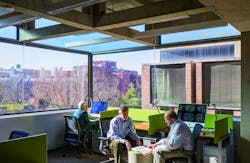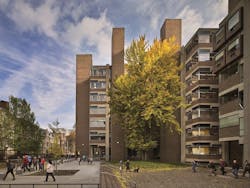College Campuses: Preserving the Past and Building for the Future
Whether a student, alumnus, faculty, staff, local resident or someone who simply admires good architecture, it’s not difficult to see why college campuses are special to many.
Campuses are important places within many towns and cities, mini-urban areas consisting of buildings and spaces that function alongside, and often with, the urban and suburban places they inhabit.
Campuses also are integral to an institution’s identity and contribute to the perception of what the institution represents. At best, they create a vibrant environment for those who work there, those who visit and the students they serve.
Many students look back on their years at a college or university as a pivotal time, one where unique memories are made, so many of which are associated with people, but also to specific places or spaces on campus.
That said, many of the beloved buildings on campuses were built long ago—dating back as early as the eighteenth century to colonial times—and many have seen the damaging effects of age or have since become inefficient or even non-functional, as needs and standards for comfort, teaching and learning have changed over time.
As campuses contemplate what to do with these often-obsolete buildings, the simple answer to the question of whether to maintain a building’s heritage or to modernize is often “both.”
Over my 20 years of working on existing and historic buildings on college and university campuses, I’ve learned modernizing is essential and inescapable. Achieving the needs of the now is an imperative. That said, heritage is also a factor to remember. This is a topic that is often not discussed in the busy preparations to renovate a building. However, it’s one that bears study.
In my experience, acknowledging the past is something clients celebrate, too, when they see an outcome in which the inherent unique aspects of an existing or historic building are celebrated. This is the “wow” moment at the end of every renovation project.
As a senior project director at EYP Architecture & Engineering, I help clients blend this nod to the past with the need to make spaces functional, comfortable and practical to those who inhabit them today.
Before embarking on a modernization project, colleges and universities can consider several important aspects.
[Related: 6 Ideas to Create Net-Positive, Ultra-Green Museums]
1. Contemplate the Past
When making updates to a campus building, understand all aspects about the building. Original drawings and evaluation of the existing building are key. Structure, geometry, bay widths and floor-to-floors are existing givens, parameters that an architect and owner must work within for a practical and successful outcome. Existing exterior envelope, the walls and roof often need attention to update or upgrade them to today’s standards.
Further, a close-in study of aesthetics and character, looking at what’s remaining and what can be reused is that extra step that allows the existing building to show a past that can enrich the present.
2. Consider the Present
The step most colleges and universities contemplate in the renovation of a building is how to turn this old, often-obsolete building from a liability into an asset. How is the building being used today? What is the best adapted or new use for the building? How can the building be modernized to become more comfortable and engaging to people in the 21st century?
If a university is willing to invest in a building, it’s imperative that the building be functional for today. Without that, a building will continue to underperform, and will become obsolete over time. Creativity is often the answer in how to rethink a building’s use, one that pairs with the inherent “bones” of the building to practically achieve an outstanding outcome.
One example is the renovation by EYP of the famed Richards Labs, a significant modern building by Louis Kahn at the University of Pennsylvania. This building, although an icon to architects and architectural historians, was not a successful building for its users due to a few (seemingly small) and yet significant practical issues.
To ameliorate these inherent problems, the university, with EYP, found a new, appropriate function for the building that, in combination with smart improvements at the exterior envelope and with the mechanical system, gave a new practical life to this treasured icon—a solution that also preserved the most important features that defined the character of this building.
[Related: How Will Education Design Change in a Post-Pandemic Environment?]
3. Prepare for the Future
Along with the past and the present, it’s just as important to consider the building 50 or 100 years from now. Campus plans are a chess game of existing and new given ever-present change within the curriculum and research. The result is change and/or expansion, affecting pathways, spaces and buildings.
Keeping an eye out for the future, and how to retain important existing assets, makes a simple renovation of one building important within the overall campus strategy for development, especially if legacy is important for that institution to consider in the years to come.
4. Hire the Right Engineering and Architectural Firm
When renovating or modernizing a building, choose an engineering and architectural firm that has the proven experience and creativity needed and look for one that is in sync with you, the college or university regarding the importance of campus heritage. That firm should have the talents and foresight to blend both form and functionality, since both aspects will live on for many years to come.
The right engineering and architectural firm also will make the difference between a superficial update that becomes outdated in a few years to one that can update a building while at the same time, revealing the inner, timeless beauty of a hidden gem. And with that, the legacy of memory and time is something that can continue well into the future.
About the Author:
Deborah Fritz is a senior project director and senior associate at EYP, an integrated design firm specializing in higher education, government, healthcare, and science and technology.
Read next: How Technology Can Help Higher Education Transition Post-Pandemic
About the Author

Contributed Author
BUILDINGS partners with industry experts to bring you contributed content covering the hot topics for building owners and facility professionals.

